
The Supply Store
Back to YouCanDraw .Com
Noses: Modified Contour |
You're advancing rapidly! Fantastic. In this exercise, you're going to dive right in and do a modified contour drawing of the nose - as viewed from the right of the drawing subject. (You'll be looking at the nose from the right - a "three-quarter" view.)
Recall, modified contour is just like pure contour except you get to look at your paper. You spend 90% of the time looking at the subject (parts of the nose in this case) and 10% looking at your drawing. You begin to size the proportions of your drawing by sight. That is, by comparing, judging angles, relating one line or part to another you can reproduce a drawing that looks like the subject you're drawing - with all its proportions intact.
Formats are the framework (rectangular in this case) you draw your exercises in. You can print them from their separate pages or trace them right off the screen.
Approaching this as a modified contour drawing.
Illustration #1: the Nose - (3/4 view)
Step 1: Setting up
As in the other exercises, read all the steps before you begin. You'll need to draw a format or print the pre-sized proportionate format on the next page. (Format )
Try to allow yourself 30 minutes of time to do the drawings. (If you have an hour, all the better; if all you can put aside is 15 minutes, then work with that. A consistent 15 minutes 3, 4, or 5 days a week will yield more lasting results than 1 two-hour period.)
Tape down your paper like you did in lesson 4. You don't want it moving around.
Now look at your screen. You should have the Nose right there on the screen in front of you (it's in step 2 below). Since you've probably never seen a nose this way, it'll be slightly foreign to you. That's great! What we're trying to accomplish with this is find a view of facial features that's complex and interesting: one you're left hemisphere will want to reject and allow the R-mode to take over.
Step 2: Getting acquainted with what you'll be drawing
So, now that you've comfortably positioned yourself, give the noses on the screen a good look. Observe them. As you did in the pure contour exercise, start in one spot, with any contour - any one. With your eyes, (it's not time to draw anything yet) track the contour lines all the way around the shape. Look at the texture, look at the shapes in and around the different wedges of the nose, (the wedge at the nasal root, the central diamond wedge and the bulky tip/wings of the nose).
Illus. #2 -Three quarter view
from the right
Illus. #3 - A side view of the nose
Allow the shift back to R-mode to begin. Be aware again, of how this shift in perception feels. I want you to start with the "General shapes" illustration (just below). The steps here are exactly the same as they were in the ear drawings you did.
Illus.
#4 - The "general shapes"
of the nose
Take a good long look at the main outline, the overall shape of the nose (squinting will help in this). Close your eyes. Imagine in your mind this outline is bordered by a vertical and a horizontal line. Open you eyes. There it is, framed within the format. Pick one of the longer lines, margins or contours. Focus in on it.
Regard that single line as an arm of an angle. Now compare that angle to how it opens towards or away from either the vertical or horizontal lines you've imagined or that you see formed by the format:
Illus.#
5. I've picked 2 diagonal
lines on the nose's left side
Now look at your paper. Imagine how that angle, how that line would look drawn on the paper. Also picture where it will be placed on the paper. To do this you need to sight the distances from the top and sides of the format. Then envision on the drawing paper where this section of line begins. Lastly, you need to judge it's length. (Not quite time to start drawing yet.)
Note: the line you're' envisioning is the line with the curved arrow pointing to it in the picture directly above.
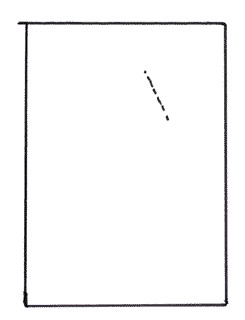
Imagine where the first segment
will be drawn
Go to the very next adjacent line section and determine it's angle, length and placement within the format. Ask "how does this line segment angle towards or away from the vertical or horizontal lines?, How long is it in comparison to the format - and to the line I've just drawn?".
Imagining this next line
drawn within the format:
(Note: compare this next
illustration to the one above.)
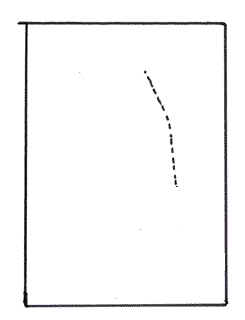
And then imagine the next section...
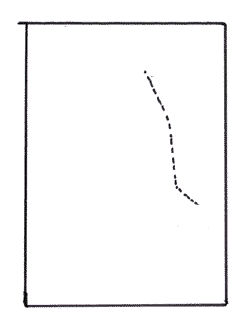
If you were drawing this, you'd be drawing the next adjacent line or contour, following each through it's course, short or long. You'd continue comparing those lines to the vertical and horizontal of the format noting the angle it makes. You'd also be comparing it's length compared to the sections you've drawn before.
and then the next contour...
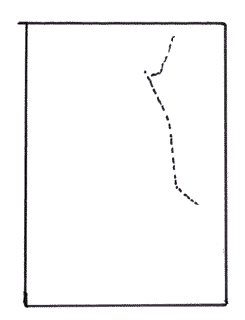
And the next 2 sections...
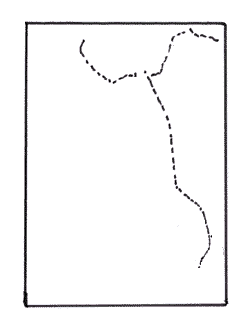
And so on...
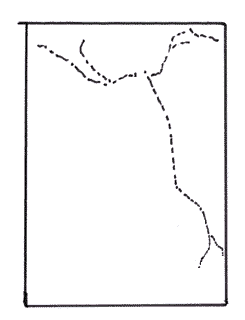
I took a bit of a leap here - look and you'll see instantly which lines were added between this and the previous picture. Challenge yourself to see the "negative space" formed between them.
ETC.....
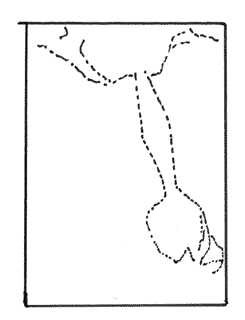
You're getting the idea...
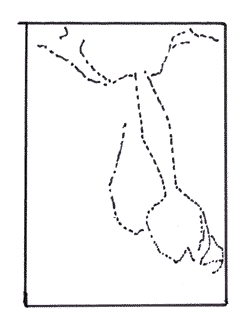
And the next - it's really taking shape...
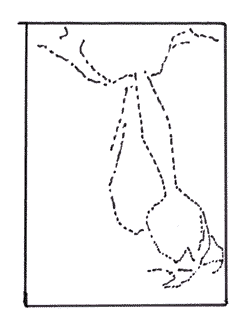
Still more...

and more...
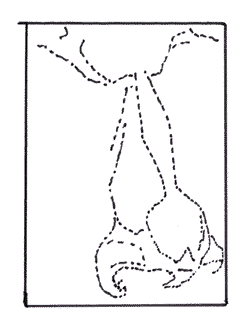
The Final Picture
Now you have the
idea
Step 3:
Begin Drawing
To repeat: Fix your eyes on any line, (or contour) that grabs you. Again, in comparison to vertical or horizontal, ask which way does it go? Which way does it angle? I'm easing you into making it a habit to compare contours, or any line for that matter, to real or imagined vertical / horizontal lines and to the lines adjacent to it. Draw the nose in the "Final Picture" illustration just above.
Now, as you did in lesson 4, begin slowly moving your eyes along the contour, and start recording with your drawing pencil, all the same perturbations, undulations and curves at the same slow pace as you see them.
When you finish one line or contour, draw the very next one, the one immediately neighboring the line you just finished. Then go to the next, and then the next. Draw the lines and contours as they come up: don't try to draw a big outline that you'd have to go back to and fill in later.
There's no need to talk to yourself, or use language at all. When you're in R-mode, there's no use for words. R-mode does fine entirely without words. Just keep referring to the screen, wordlessly comparing, relating, and scanning what is before your eyes.
Reminder: words only get in the way. No need to say things like "well if this part is here, then this must go there..." - you don't have to reason anything out. Just draw what you see. It's all right there. Focus on how one line or contour seems to arise out of the one before it, compare widths, angles, and lengths. Compare those lengths or angles to the one you've just recorded.
If it seems easier, go through the step by step illustrations above and draw the added lines as they appear in each picture. If you do this, I recommend going back and doing one more drawing of the final picture without referring to any other picture.
Keep Going....
You can look at your paper occasionally to reference a relation, a starting point, or a quick proportion. But don't get hung up on it. You're bound to have discrepancies in relative size and proportion. Don't' worry!
Like the pure contour method, the vast majority of your time in this exercise should be spent on observing and recording what you see. Maybe 10% of the time should you be looking at the paper.
If you get stuck on a part that seems too difficult, the tendency is to access your memory - this pulls you out of the real-time, in-the-now, direct experience of R-mode. To avoid the "memory bin trap" of L-mode do this: Draw the area or contour immediately next to or around the troublesome part. That will shift you away from naming it, will steer you around L-mode, and head you back into R-mode.
Step 4
As a reminder: everything you need to know is in front of your eyes. You just need to observe those perceptions - no reason to think, no need for words. The finished picture will be a recording of those fresh, honest observations you made while you were immersed in R-mode.
So that's your job: play reporter and get your observations down. Since you don't need to do anything else, this will feel easy, you'll feel relaxed, and confident as you get engaged with the information in front of you. You'll be fascinated how the puzzle pieces will come together.
You've set up the conditions so R-mode can process the information. And that's why once you can leave the critical, domineering, belligerent L-mode behind, it becomes easy. What you see is just "information". And you're the conduit between the "information" and the paper.
Homework Following the exact same steps do:
"Wedge Nose"
The detailed
infrastructure (There are 4 formats on the format printout page to do your drawings in if you like.) Kasbohm & Company's YouCanDraw.com © Copyright, All rights reserved 1997 e-mail: jeffkaz@YouCanDraw |